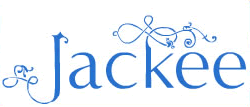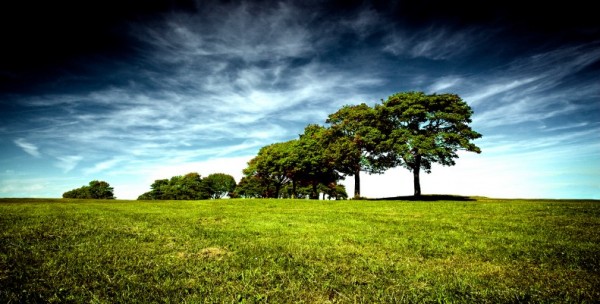Archive for August, 2014
Friday, August 29th, 2014
Since I was a little girl I have always found comfort and refuge in words, whether these were my own words or the words of someone else. Recently a dear friend reminded me that in primary school I would write deep, meaningful poems- a memory I had long forgotten about. At that age, I was deeply wounded and feeling very alone. The poems were my way of revealing the hurts I could not speak aloud.
I have been journaling for over 25 years – a practice which has helped me navigate my way through a serious trauma in childhood, domestic violence, depression and debilitating low self-esteem. Journal writing has enabled me to see life in a new way – not to sleepwalk through life but to see life more clearly. Journal writing has literally saved my life.
The blank page is an invitation to write the truth about our lives no matter how difficult and messy that might be. It’s a safe place to reveal and explore our truths and the rawness of our emotions. It is a place of growth and healing. Jessamyn West said, “People who keep journals experience life twice.”
Sexy, Sacred Journal Writing is a six-week online course that shows you how journal writing is a restorative practice that you will help you become more of who you truly are.
Why sexy, why sacred?
I have always believed that in a pure sense the the meaning of the word sexy does not refer to sex in a dirty way but to a woman or a man who appreciates the divinity and gloriousness of their bodies from the inside out and who is not afraid to allow that to show.
Sexy is the way I feel about journal writing. It’s a space where I can unravel myself and write myself to wholeness, which allows a connection of feeling good that travels from the inside to the outside. When you write in a journal you know about it, you feel it, other people feel it and sense it and I believe we not only feel act better but we feel better.
Sacred is a feeling I often connect with when I have deepened into the practice of writing and creating in my journal. Whether it is evolving a feeling of gratitude at the end of several pages of completing or moaning or as a result of writing and gaining an insight or understanding that has stopped me in my tracks and causes me to breathe deeply in the space that has opened up in the moment.
The bringing together of the word sexy and the word sacred remind us that all moments in life hold the possibility of transformation, healing and enlightenment. It was hard to use the word sexy in the title of this course, but I stand by it. I hope you will too.
What is this course really about?
- This course is also about smelling the roses and savouring the small delights and moments in daily life.
- Its an invitation to open up to how you can make your day more meaningful through writing and journaling about what you see, observe, hear and intuit.
- It about connecting to things, people and activities that bring you joy, satisfaction and fulfillment.
- Sometimes journal writing can be a very isolated practice triggering feelings of loneliness. Learn how aware journal writing can transform loneliness to appreciating the gifts that aloneness gives you.
- The journey of Sexy, Sacred Journal writing is the journey from suffering to surviving and how to move to a place of thriving.
- This course will help you find your voice and also how to use your voice both on and off the page.
- Identify in times of darkness and challenge where the light gets in and how to use this light as a guide to your way through.
So what do get by joining Sexy, Sacred Journal Writing?
- You walk away with a succulent range of journal writing techniques and habits (you choose what works for you)
- You’ll learn from seasoned writers and women just like you about their personal journeys and relationships with their journals and relationship through nine video inner-views with our journal-writing experts.
- You’ll leave with an illuminated and informed understanding of how journal writing is both a restorative practice, a form of self-enquiry and self revelation and how it is a new and emerging therapy Jackee has created called, “Paper Therapy” more here
- You’ll gain insight and perspective from your journal writing entries that will help you to grow and become a better and more enlightened person.
- I will be active in the discussion forums where you can share your experiences and responses to ach of the different lessons, ask questions, talk through challenges and any resistances you might be experiencing. How much you engage with on the forum is up to you. I’ve been a participant on online courses where I have greatly benefitted from being active on the discussion forums and then other times when absence and silence was absolutely what was required. Use the discussion forum in the way that works best for you.
How will you know whether Sexy, Scared Journal Writing is right for you?
- Are there things in your life you find difficult to talk about and share with others?
- Have you tried journaling before but found that it made you feel worse rather than better?
- Do you feel that you have lost your touch and your sense of yourself in your relationship, your job or your career?
- Have you lost sight of what makes you uniquely you?
- Would you like to know that you have generated a body of work that records who you have been, where you have come from and a written testimony of what you have come through?
- Would you like to know about the scientific research that confirms how writing and keeping a journal helps with managing change and transforming our lives?
How the Course Works
The course consists of three weekly lessons for six weeks as well as weekly video inner views from our delightful community of journal writers.
Register
The course begins on Monday 5th January 2015 and you can register online now.
Please get in touch with any questions
Course Fee
Exclusive Festive 2-4-1 Offer of £57 ends on 29 December 2014
Early bird offer of £57 per person from 30 December until 2nd January 2015
Standard Registration after 3rd January 2015 will be £79 per person
1 Comment
Wednesday, August 20th, 2014
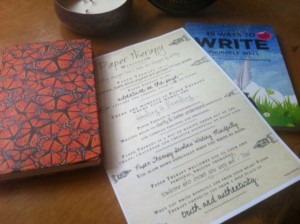
(Quotes in brackets form part of The Paper Therapy Manifesto 2014).
A Manifesto is a personal declaration based on a belief or something that you strongly stand for or advocate
I’ve always been a bit of a writing geek. At secondary school I went to great lengths to design fabulous cover for my history projects as well as illustrating all my content, which always earned me straight A’s in the subject.
In the last few years much of that passion has resurfaced in the creation of a series of manifestos. Manifestos help me to get to the roots of why a particular practice or activity is of value. Then by turning it into a manifesto it becomes a powerful written reminder of why the topic of your manifesto matters. That’s why Paper Therapy has become the fourth in my series of Manifestos. The first three were: The Writing Manifesto, The Creativity Manifesto and The Nature Manifesto, which you can download for free by clicking on the links.
The new hot off the press Paper therapy Manifesto is a call to the magnetic practice of journal writing based on my belief that (Writing changes lives and lives are changed by writing).
I’ve been journal writing for over 26 years. I started writing regularly in a journal a year or so before my daughter Aida was born. Over the years journal writing has helped me through various bouts of depression, a serious broken heart, a meltdown around my career, financial hardship and the high’s and lows, swings and roundabouts of daily living (Paper Therapy is Transformative. Writing helps to clarify and better understand difficult feelings and emotions).
The practice of journal writing has become both a daily ritual and a place where the quiet practice of journal writing returns me every time quietly to myself. It’s where I get to express myself, to hear and listen to my inner voice and not get carried away by the hustle and bustle of the world around me (There are moments in Paper Therapy when your words are healing and revealing).
What I appreciate about the practice of Paper Therapy which journal writing is part of is that (Paper Therapy is inexpensive, doable almost anywhere and you have 24 hour access). I like the fact that it’s possible to engage in paper therapy almost anywhere, from the top of the 37 bus, at the wheel of my car, in a park under a tree, in a corner in a busy café or scribbling in the dark of the local cinema screen
I find the regular practice of journal writing both therapeutic and calming. It takes me out of the roller coaster world of the busy mind and transports me into the world of quiet mind in minutes (Paper therapy involves writing mindfully. You slow down especially when you write by hand).
Sometimes I write loads in my journal, flushing out all the toxins and negativity from my day. On other days it’s just a sentence or two to remind that I’m still here. Most of the time because of it becoming a practice the page is alight with ideas, musings, seeds of thoughts and possibilities about life and work (When you write honestly and from your heart Paper Therapy connects yourself and others from a deep place of truth and authenticity).
In my world Paper Therapy embraces the ordinariness of life, sharpening the quality of my awareness and presence
(Paper Therapy is an adventure on the page – Explore and unravel your life on the page). In-between jottings of deep reflective thoughts and inquiry you’re just as likely to stumble across a shopping list with items like cod and potatoes. The sacred and the routine sit side by side.
There’s no showing off or points to prove in the journal (what’s the point), only showing up. We get to show up, as we are. If we’re brave enough and honest enough, we show up sometimes naked, without the buffing up, the job title or choosing the option of hiding behind material possessions. Instead it becomes just you and the blank page, (Paper Therapy welcomes you to your own personal writing therapist, someone who knows you very well).
The writer Flannery O’Connor said, “If we survived childhood then we have enough material to last a lifetime.” Put this together with some wise words from Ernest Hemingway, “ The world breaks everyone and afterwards many are strong at the broken places,” so the fact that you’re alive means you have enough material to write about in your journal or notebook to last you a lifetime.
In a recent blog post for the entheos academy author Mozart Gurrier shared an example about children in a homeless centre where the facilitator sets a chimer for three minutes and gets them to write. Read more here
This is a brilliant example of where an organization has embraced the practice of #papertherapy.
- Think about what and how our schools would be different if students were given 7 minutes at the start of the school day to getting their feelings down either digitally or on paper in a session rightly named #PaperTherapy.
- How much more and aware and in tune would our teaching staff be all round if permitted to do the same?
- Think about the conflicts, the bullying and harassment that would be eradicated workplaces if people learnt the rules of engagement with the blank page that showed them how to take ownership of their own emotions and feelings (Paper Therapy is a way of making order out of the chaos and challenge of everyday life).
They would learn how not to spill and leak emotions all over the place a point eloquently illustrated by the writer Alexandra Johnson in her book, Leaving A Trace: On Keeping A Journal. Alexandra shares some of the possible pitfalls for those not used to keeping a journal when she writes “Trust that the bore bending your ear on the plane or the ranting taxi driver on the ride home never kept a journal. That egotism leaks out publicly instead. You become their journal, a live blank page, held hostage in a seat. Think of journals as a safe, private way to have it siphoned off, rethought, vented … “
- Think about how much money and pain would be saved in divorce settlements and child custody cases if parents and families learnt how to make paper therapy a way of family life?
- Prescriptions for anti-depressants in the UK has increased by 495 percent since 1991 (Huffington, 2013). What if GP’s handed out paper therapy prescriptions instead of tranquillizers or encouraged patients to put pen to paper? And what if Dr’s self -prescribed some of the same paper therapy as they prescribed to their patients?
- What if healing and restorative poems from across the ages and modern times were available free of charge on the NHS? Numerous research is indicating that reading poetry creates new neural pathways in the brain.
Paper therapy works for me however it doesn’t make my life perfect. I still have to deal with messy stuff like everyone else does. I make mistakes, get things wrong and piss people off! But perhaps this quote from the book, The Pen and The Bell: Mindful Writing In A Busy World will give you a better understanding of how journal writing has contributed to me becoming a much better person in my life than the person I would have been had I not embraced it as a practice.
Writer Kim Stafford likens writing to playing the violin. He says that a violin played everyday will keep the vibration of the music in its body, even while lying still and silent. If it is not played everyday the vibrations dissipate and the wood grows lifeless.” Journal writing gives my life vibration.
The other aspect of journal writing I wholeheartedly appreciate right down to the bones about it as a practice and a way of life is how I have grown to love fiercely the woman who has inhabited the thousands of pages of journals and notebooks that I’ve filled.
My Paper therapy journey has been like a seed planted in the earth. Every word, every paragraph and every line has been turned over and mulched into the fabric of my daily life. The pages of my journal have been the earth and the soil in which I have grown. Each journal from cover to cover has watered my life. Nothing I’ve written has been wasted.
When I don’t write regularly, when writing is not at the core of my life it feels as if I’m skimming over the surface of life. When I write often and regularly I’m noticing how my hunger for the things in life that are addictive and unhealthy is greatly reduced. My digestion of everyday experiences is clearer and more of a felt and lived experience when I write.
Through the paper therapy journey I’ve grown to accept and not reject the woman I have blossomed into warts and all.
Welcome to #papertherapy. Let the writing and the inside out change process begin. I want to be part of a revolution on the page knowing that (writing changes lives and lives are changed by writing). Will you join me?
Download your free copies of the Paper Therapy Manifesto 2014 here:
If you are inspired please feel free to spread the word and share the love.
With Love,
Jackee
No Comments
Sunday, August 10th, 2014
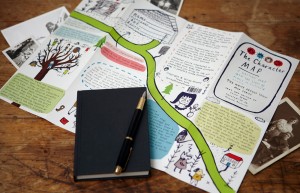
The Character Writing Map: Click here
I love it when I come across new, juicy resources for writing that make getting onto the page a more enjoyable process. With our busy lives it can be so easy to run ourselves ragged and have very little time for the writing process. That’s why I was delighted to come across Shaun Levin’s Writing Maps. I purchased eight in one day simply because they are so good as visual, illustrated writing prompts for fiction and non-fiction writers.
I’ve know Shaun for a few years now and was excited when he agreed to be featured on the blog as a guest blogger talking about Writing Maps. We share a love of paper and I love how the Writing Maps emerged from his Inquiry question about ‘What next in his journey as a writer?’
Read on to hear what the fab Shaun Levin has to say about Writing Maps and how they creatively nourish and inspire our writing:
I suppose the Writing Maps are a way for me to take stock of 20 years of teaching and running workshops in all sorts of settings: colleges, universities, schools, as well as more public spaces, like art galleries, parks, cafes, department stores, a zoo, a cemetery, on a boat.
Much of the material for my teaching comes out of my own practice as a writer and very crafty techniques for combating my own resistance to actually sitting down to write! I’d say that most of my work has been written outdoors, or at least started when I was away from my desk, out of the house, in cafes and on park benches pretending I wasn’t actually “working”.
And then there’s my fascination with the combining of text and image. And my interest in psychogeography and creative mapping. I don’t remember exactly how it all became aligned, but at some point I must have thought: let’s put creative writing prompts onto maps! It was a bit of a eureka moment!
To be honest, I think the Writing Maps also started at a time when I wanted something new, to try new things. I was about to turn 50 and was questioning a lot of what I was doing, asking myself whether this was it, whether I would just keep doing the same thing for the next 50 years, publishing another book, teaching another workshop, publishing another book, etc.
I know that if you’re a writer then that’s what one does, but I was questioning that! Working with a range of different designers on the Maps has given me more confidence to explore my own very limited illustration skills and to kind of enjoy the beginner-mindness of something I’ve never done before but have always wanted to.
Drawing! Visual art has been a huge part of my work for the past 10 years – I’ve been writing about painters, researching painters, visiting artists’ studios, but never really giving myself license to explore the challenge of creating without words. So that’s all been exciting and new and who knows where it will lead!
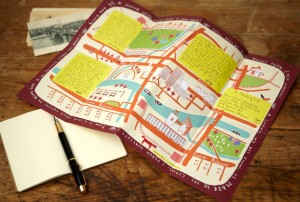
The City Of Inspiration Writing Map: Click here
Talking about new things… In March this year (2014) I started a monthly writing contest that links to the launch of a new Writing Map each month. The first 12 winners (two from each month) will be published in a new literary magazine that’ll launch in September. It’ll be called A3 and will be on an A3 page, like the maps, and will fold down to A6 (postcard size).
Maybe it has something to do with the way we carry our phones around with us, so much of what matters to us is in this one device… so the Writing Maps and the new literary magazine will be things you can carry around with you. I guess it’s my love of paper combined with the convenience of having inspiration and beautiful things with you at all times.
Publishing other people’s work, which I’ve been doing for over ten years, has always been about sharing exciting work that I’ve come across. Like, look at this amazing bit of writing I’ve just read! So the new journal will be very much about that. Often the most powerful writing comes out in the shortest time. It always energises me when you give people in a workshop a really simple prompt and in 5 or 10 minutes they create this moving and surprising work.
I want the Writing Maps to inspire that kind of writing! I’d love them to be the thing you carry with you wherever you go. I want the Writing Maps to inspire people to write stories or explore in deeper ways the stories they’re working on.
The whole idea behind Writing Maps is that the world out there is full of inspiration, that basically the world is one big creative writing (or drawing, or painting) prompt, and the Maps are made up of suggestions to channel that into stories, to make stuff out of what’s already there! Writing Maps are for anyone who is interested in writing and who is open to trying out new approaches to creating stories.
I think writers are always looking for new ideas for stories, or an interesting way to tell the next story, so hopefully the creative writing prompts Writing Maps will open up new possibilities for writing adventures.
About Shaun
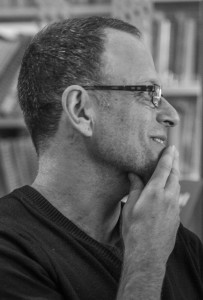
Shaun Levin is the author of five books, amongst them: Seven Sweet Things, Snapshots of The Boy and A Year of Two Summers.
His fictional work on the poet and painter Isaac Rosenberg has recently been translated into French and will be appearing in September 2014. His short stories and essays appear in over 50 anthologies and journals, and he was the founding editor of the literary and arts magazine, Chroma.
He launched Writing Maps in 2012, and is about to launch a new literary journal, A3.
No Comments
Saturday, August 9th, 2014
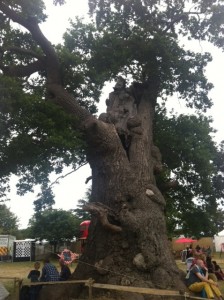
“Every tree is important.” – Ted Green
Yesterday I was so pleased that I got to attend the ‘How To Look At A Tree’ workshop at the Wilderness Festival. I was still working when the workshop started but managed to get into the workshop a few minutes in and I’m so glad I did.
Anyone who knows my work and me well knows how passionate and excited I am about trees. So meeting Ted Green and Jill Butler for the first time was great.
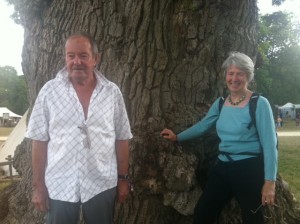
We share a passion of a love of trees. The way they spoke about ancient trees and our need to preserve them as natural monuments was music to my ears. I knew I was amongst my tribe. I learnt new knowledge about ancient trees during the workshop and it rekindled my interest in ensuring that more trees in our neighbourhoods and out in the wilds become protected species.
For years I have gone about speaking one on one with trees across London. They really are the best silent counselors. I’ve meditated and wrote in my notebooks and journals underneath the huge sprawling crown of my favourite Oak tree that sits on the top of the hill in Brockwell park in South London. In the past as part of weekend retreats I hosted I would lead sacred ceremonies under the gaze of huge Oak trees and only last week I bumped into a couple who invited me eight years ago to officiate a wedding blessing on their wedding day under the watchful gaze of one of the oldest Oak trees in the same park.
What Ted Green founder of the Ancient Trees Forum and Jill Butler of the Woodland Trust (best natural and real co-facilitation I’ve witnessed in a long time – they were your ultimate keep off the script double act!) reminded me of were the three things to look for that tells you a tree is ancient (over 500 years old):
• Firstly the width of the tree’s girth is often a sign of it’s age as ancient trees add a new growth ring each month
- A shrinking crown growing downwards is a sign that the tree is slowly dying of a well-earned ancient age
- Ancient trees become hollow due to the central wood decaying
- Ancient trees tend to be 500 years old and more.
- A Veteran tree is usually in the second or mature stage of its life
- A notable tree is a tree of local importance, or of personal significance. It is likely to be a next potential veteran tree.
My blog contains lots of stories and personal narratives of notable trees that are of personal significance. I loved it when we went out in the middle of the festival amongst all the events taking place and people wandering around to visit what (was what I have now named the Wilderness Festival tree – thanks Jill) was a marvelous specimen of an ancient tree, which is over 800 years old.
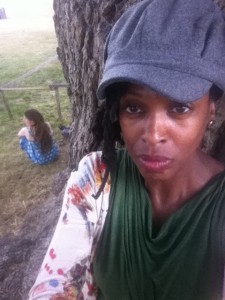
A Selfie in front of the 800 year old Wilderness Tree 2014
Trees have an amazing life cycle and the dying process of an ancient tree could take some 300 years. Trees are resilient, adaptable and extremely flexible. There’s a lot we humans can learn form the life cycle of a tree. Ted made a good point that visitors pay money to go and visit Windsor Castle and on the walk from the gates they miss the magnificent ancient trees that they are mindlessly walking by.
People will pay to go visit Nelson’s column at Trafalgar Square, art installations and various monuments and statues scattered around the UK. Yet we struggle to give reverence to the magnificent trees that have survived over hundreds of years and are responsible for keeping us humans alive.
This is in distinct opposition to the customs and traditions of many of the ancient cultures across the globe who honoured and celebrated paying reverence to trees. This could be through ceremony and ritual, asking permission to be with the tree or leaving the tree a gift as a way of saying thank you for all you have given.
The ancients knew and appreciated the many usages trees had to offer community from it’s wood, to shelter, to providing different habitats for different animals to its sacred and ceremonial energies. In many cultures trees have been community meeting places and important places in village life.
If we think about it wholeheartedly we owe our trees a great deal. Tree’s stabilize the soil, store carbon, generate oxygen into the air and I for one would rather do what Wendell Berry writes in the poem ‘I Go Amongst Trees’, “I go amongst trees and sit still/All my stirrings become quiet …..” Visiting, sitting and being with trees is one way in which I quiet my mind and practice mindfulness.
When I need to recharge my battery it’s the Oaks I turn to. Only a couple of weeks ago on a visit to Chelsea Psychic Gardens I watched as a woman stood with her back straight against the bark of a huge tree and read a book. It looked so natural and comfortable. See if you can spot her in the photo below? It’s dark because I was some distance away.
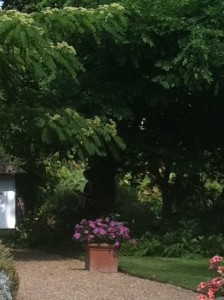
Can you spot the woman in the above photo reading?
At the end of the talk Ted and Jill encouraged us to log trees in our area we believe are either ancient or need to be protected on the Ancient Tree Inventory on the Woodland Trust website which includes a simple recording form to send in the details of your ancient tree.
Here’s a link to the page of the Ancient Trees website where you can register trees or get in touch with The Woodland Trust:
In the meantime why not use this glorious weather to make friends with the trees in your neighbourhood.
- Where are your ancient tree’s in your neighbourhood?
- What are the notable tree’s of personal significance or local appreciation?
- What trees would you name as the Veteran trees in your area?
Trees appreciate being acknowledged and appreciated. They ask for so little and yet give so much. Enjoy and take care of one of nature’s natural monuments. Thank you Ted and Jill for a great talk and field trip as part of the Wilderness Festival 2014. I’ll be in touch.
No Comments
Thursday, August 7th, 2014
Welcome to the new PAPER THERAPY MANIFESTO. We hope you’ll enjoy using it.
Download your copy here.
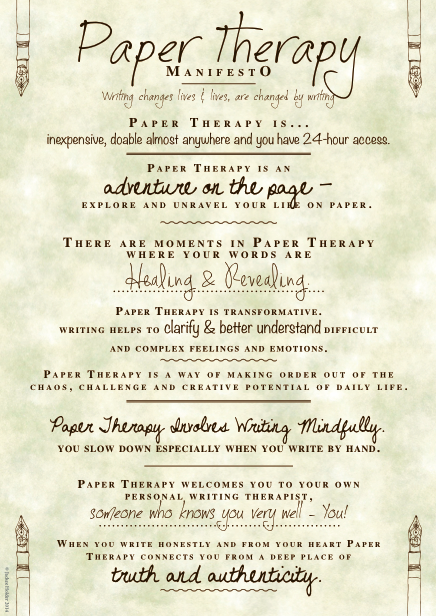
1 Comment
Sunday, August 3rd, 2014
My friend and fellow author Ji Hyang Padma author of the lovely book, Living The Season: Zen Practice For Transformative Times recently invited me to take part in a “Blog Hop”. It required answering some thoughtful questions on my writing life. Here’s what I had to say and a link to her blog, Natural Wisdom
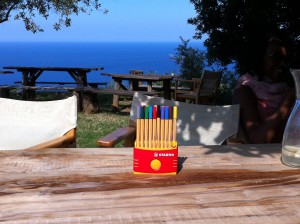
What am I writing/working on?
When it comes to writing I’m always working on something or other, whether it’s personal writing or writing for publication. Writing creatively in some form or shape is an everyday occurrence. I do feel lost without my journal, a blank index card or the Notes app on my iphone.
At the moment I have several writing projects on the go and many that are near completion or needing to meet a current deadline.
These include: Two articles for a print journal and an online magazine. The topics are: Exploring the impact of race and diversity in coaching and the second is a feature on Mindfulness for women.
I’m just putting the finishing touches to my latest Manifesto, Paper Therapy. We did have an original design but it didn’t make my heart sing so I put it away for a few weeks and then the other day on my travels I came across a design that gave me the ideas for a new look for the Manifesto which I now love. It’s just in time for a workshop I will be delivering at a summer well being festival here in the UK.
I have two online courses that I’ve written which require tying up loose ends and I’ve gifted myself the month of August to birth both of these projects. This is both an exciting and scary time for me as it is taking my work into new arenas. So watch this space.
As usual I’m late in completing the content for my website’s monthly newsletter. I just never seem to be able to generate this in advance. I’ve tried programming the topics in advance for the year but it felt really stilted and I found the writing didn’t flow. But part of me knows that I enjoy working close to the bone so I’m kind of accepting this and not nagging myself about it too much.
I’m playing with the idea of a submission of a ‘Wild Bio’ to a website where I can share more of who I am with a wider audience and an article/blog post on the writing retreat I led in Greece at the end of June, early July. I’ve been sitting with the idea for a few months now and the time now feels right.
I am off for the month of August, which I’ve dedicated as a month of writing. I’ll be staying in London but have planned to explore and hang out in as many London hotspots in nature and culturally as possible. • During my writing vacation I’ve set an intention to leisurely draft the synopsis for my new book whilst wandering and exploring. I’ve given myself permission to be relaxed about this. I’m not one of those writers who can write a book in 90 days. I need time and space and creative oxygen.
How does my work differ from others of its genre?
Personally I feel I have risen to my own personal challenge of breaking down that barrier of an assumption I carried that to be a coach who works in the corporate sector I have to present a certain professional image (what a load of crap). My challenge to myself was to be brave enough to talk and write about all aspects of my life and expose this on social media. This includes writing about spirituality, the creative process, mysticism and all things alternative that I have something to say about.
There was a time I believed this would go against me. Was it credible to call myself an executive coach and then in the next breath write blog posts about trees, poetry and sacred spaces? Was it okay to disclose that I have over a hundred journals, that I was ordained as an interfaith minister and that I love candles, incense and the moon?
Now I realize the gift writing continuously offers me is to not hide those valuable and essentials parts of the self. The more willing I am to reveal all of who I am including the shadow selves and vulnerabilities that are all a part of me, the more I connect to my wholeness. The better placed I am to model that for others, hopefully offering them permission to do the same. At the end of the day we attract the people and organizations that resonate with how we show up. We all have a magnetic transmission to attract our signature tribe. The key is to be authentic in your own unique way and that is what I aim for as well as I can on any given day.
Why do I write what I write?
On a daily basis I am inspired by nature and the creative process and how this influences our inner lives. I do not see this as separate from my work as a professional coach and speaker. I’m very connected to life’s finer detail, the subtleties, the deeper meaning of life. I capture much of what I see observe, sense, smell, hear and experience in my journal and notebooks.
This habit has helped me stay grounded, strengthen my resilience and expand the reach of my resourcefulness, which often generates a state of peace and calm even when things are turbulent and stressful. Noticing and writing about what I see, sense and observe as I go through my day brings life into full view.
I like that I have this private and wild world inside me that I can make sense of and integrate this into who I am being in all the different roles and persona’s that shape who I am in the world.
Writing helps me to bring both the inner and outer selves into greater alignment. I write about what I often do not say or share in public, in conversations and in relationships. Writing is my way of expressing my voice to myself so when I write I get to listen to myself first. It is a wider exploration of who I am that is often not afforded space in everyday interactions and conversations.
Writing provides a more fertile ground for what I want to say and who I want to be outside of my writing. How does my writing process work? I’m particularly skilled and confident about writing in-between the gaps during my day. By this I mean I don’t have to have designated set times and places to write. As soon as an opportunity to write shows up, I’ll grab it. Most mornings I write Morning pages as a way of clearing my psychological and emotional space. I find this extremely helpful and an affirming way of starting my day.
When it comes to writing projects I’m an advocate of writing those ‘shitty first drafts’. Getting anything down is a sign that I’m willing and ready to get going no matter how awful what I write is. This has served me a thousand times over and is the reason a body of writing work has developed and grown over the years.
I find the craft of shaping and moulding what I write satisfying even when the writing itself feels cumbersome and challenging (which it often does). I’m always trying to find that sentence or idea that I know will hit the right note or help the writing to sing. I guess I see and experience every piece of writing as a possible gift. There’s always the potential that somebody, somewhere will be touched by something that we write or share. This way I can give my work away knowing that it will find its way into the right pair of hand and eyes.
I have had the odd occasion where I have read a past journal entry in my own journal and thought how on point the person was who wrote the quote only to realize I was the author. This is an act of grace and humility and reverence for the writing process. We never really know what might be revealed that will surprise and astonish us, often when we least expect it.
I use everyday household duties as meaningful time for my ideas to percolate. The rhythm of routines like hovering, folding the clothes, filling my papers means my mind is free to go to work on bringing together and connecting ideas, firming up sentences and themes and creating structure and form so that when I arrive at the blank page or computer screen there is something there, a hook, a place to begin.
But then there are times when a writing deadline does not provide time for this kind of wandering without an agenda or a destination. This is when I write without knowing what will come and the writing guides me and shows me what wants to be written.
I’m a firm believer that writing as an art form is a mysterious process full of magic and wisdom that is greater than us. Other times writing pieces and projects are pieced together from scraps of paper, seeds from entries in my journals and notebooks or inspired ideas from quotes and books.
Some of the quotes I’ve collected on index cards go back years. I have an ability to remember a quote from ten years and can photographically recall the colour of the index card I wrote the quote on and what box it might be housed in. I’m accurate 98 per cent of the time.
I’m really motivated and energized to write when I’m traveling on trains, buses and driving in my car. I often park on quiet roads and write at the wheel. Or I park up early outside the train station before heading off to work and write my morning pages.
Everything around me is possible material for all of my writing and much of my writing is heavily influenced by what I experience in my day-to-day interactions.
I draw inspiration from beyond traditional and expected places like books, libraries or the internet. Inspiration and ideas can get sparked from a comment on the radio, a slogan on a billboard, a piece of overheard dialogue on the subway or dialogue and information gleaned from television or a movie. But I need to be receptive and open to receive, to notice and to capture it before it disappears and is forgotten. So I always have pen, paper or fingertips ready to get moving.
If you would like to read Ji Hyang’s “Blog Hop” response please click here to read and find out more about the wonderful work and teaching she’s doing.
What are some of the blogs you read?
Click to follow the links and read more:
The Vulnerability Project Click here , Laurie Wagner Wild Writing click here , Rebecca Campbell The Spirited Project click here , Suzette Clough Visual Medicine click here and Esme Wang click here
No Comments
